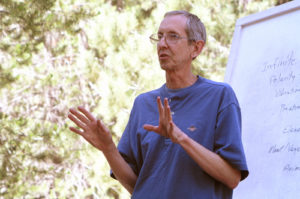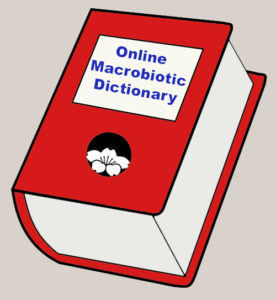
Completed Entries
Real faith is having complete confidence and trust in the natural order of life—the Order of the Universe. This type of faith involves the use of one’s supreme judging ability—a clear-sightedness of one’s relationship to people and things in the relative world as well as one’s connection with the Infinite (Oneness). “The greater one’s judging ability, the greater one’s happiness” was Ohsawa’s formulation. One expression of real faith and kindness is to give to others without expectation of anything in return.
A type of sauna that uses very long-wave far-infrared radiant heat to penetrate and dissolve fat deposits beneath the skin. The far-infrared sauna is assumed to be safer for the aged and for people with weak hearts because the user sweats at much lower temperatures than with water-type saunas.
When fats are consumed, the liver breaks them down into fatty acids and glycerol and later to simpler compounds that eventually provide energy for the body. The liver also produces bile, an alkaline substance that is important for the breakdown and absorption of fats in the small intestines. Fat metabolism is helped by vitamins A, D, E, K, and B-complex.
The body needs fat for energy and other processes to maintain a healthy condition. A typical American diet contains about 42 percent fat with 16 percent as saturated fat. A macrobiotic approach recommends a diet low in fat at about 15 percent with only 2 to 3 percent as saturated fat. Excess fat in one’s diet leads to many unhealthy outcomes, including large amounts of acid wastes that must be processed by the body to avoid an overly acidic condition. In addition, excess sugar from simple carbohydrates, especially refined sugar, converts to and is stored as fat in the body. Thus, the macrobiotic view is that complex carbohydrates are a better source of energy and that a smaller amount of fat is best for optimal health. Note that fat is a required nutrient, especially for small children during brain development; however, the type of fat and the quantity consumed are of vital importance. Fat sources include good-quality vegetable oils, beans (including soy products), whole grains, nuts, seeds, and fish.
There are three types of fatty acids: saturated, monounsaturated, and polyunsaturated based on the number of hydrogen atoms bonded to each carbon atom. Saturated fatty acids have two hydrogen atom bonds and are very stable, meaning they can be heated to high temperatures without being degraded or denatured. Examples of saturated fats include coconut oil, palm oil, and butter. Monounsaturated fatty acids have only one hydrogen bond and are less stable, meaning they are okay for low temperature cooking only. Examples include olive oil and oils from almonds, hazelnuts, or avocados. Polyunsaturated fatty acids have no hydrogen atom bonds and are very unstable, meaning that extreme care much be taken when used for cooking. Examples include most vegetable oils, including sesame oil, soybean oil, flaxseed oil, and sunflower oil. Note: The information about fats and oils has changed over the years. Many early macrobiotic cookbooks include oils like canola oil that are not used today. Here’s Julia Ferré’s explanation in the latest edition of Basic Macrobiotic Cooking, pages 16-17.
“Note on fats and oils – It is important to use quality oils and to use them in ways that are healthy. New information about fats has been discovered since the first publication of this book 20 years ago. Then, I used corn oil in baking. I don’t recommend it anymore. Corn oil requires high heat and technological processes—refinements that degrade oil’s fragile nature. In addition, oil processed from corn often comes from genetically modified (GMO) corn. Canola oil and safflower oil are inferior oils for these same reasons and should be avoided. Oil is fragile. All vegetable oils except coconut oil and palm oil denature in temperatures in excess of 240 degrees…Unrefined organic oils are preferred to ensure that no GMOs or chemicals are used. Oils that I currently recommend for cooking are…light and toasted organic, unrefined sesame oil; organic extra virgin olive oil; and organic, unrefined coconut oil. Other organic and unrefined oils such as flax, avocado, or walnut are valuable used unheated in salad dressings or drizzled on food…For more detailed information about specific oils, consult Rebecca Wood’s The New Whole Foods Encyclopedia.”
See also Essential fatty acids.
A table for feeding kokkoh (grain milk) to infants for the first weeks and months of life. Kokkoh is used in cases where mother’s milk is unavailable for some reason, or as a supplement.
Dietary fiber makes stools softer, speeds up transit time of food through the intestines, reduces serum cholesterol and neutral fat, helps prevent obesity, and increases helpful bacteria in the intestines. An inadequate amount of fiber in one’s diet leads to constipation and higher pressure in the large intestines—the primary cause of diverticulosis—and is thought to be a direct cause of heart and cardiovascular diseases, diabetes, obesity, and cancer. A macrobiotic dietary approach contains ample amounts of fiber, including whole grains and beans, most vegetables, nuts and seeds, sea vegetables, and fruits. There is no fiber in meat, dairy, or refined sugar and these foods are minimized or avoided in macrobiotic practice.
In macrobiotic practice, fish is eaten as a supplemental food in colder climates and seasons, for health or extra protein when needed, for special occasions, or as a transition to a grain-and-vegetable-based diet. Fish is a yang acid-forming food that is rich in sodium compared with potassium. Fresh fish is preferred, wild-caught when possible, and is usually balanced with grated daikon radish, grated ginger, or lemon (all yin, alkaline-forming), and/or by eating three times more vegetables than fish when fish is served. Less fatty white-meat fish is more for regular use, and blue-skinned and red-meat varieties are more for special occasions. Fatty fish such as salmon and mackerel are good sources of omega-3 essential fatty acids. Fish and fish oil also contain vitamin D and people are encouraged to get plenty of sunshine if not eating fish.
An extension of yin-yang based on seasonal changes for further classification and refinement in making daily choices. The five elements are wood (spring), fire (summer), earth (late summer), metal/air (autumn), and water (winter).
The flavors corresponding to the five elements of the five-element theory: sour (wood), bitter (fire), sweet (earth), pungent (metal/air), and salty (water).
Similar to adaptability, flexibility overcomes rigidity and allows one to be open to new ideas and opportunities leading to a more active life. Flexibility (yin) on the outside and firm (yang) on the inside is considered to be a better combination than strong (yang) on the outside and weak (yin) on the inside.
One’s physical, mental, and emotional life depends on the nourishment of food since foods determine the condition of the vital organs including the brain. Principles used are selecting local, in-season, indigenous, and organic foods and choosing as wide a variety as possible.
The prevailing macrobiotic idea is that fortified foods are not needed under normal conditions for people eating primarily whole foods. This thinking assumes that nature provides everything one needs. As soils become more depleted, foods have less nutrients and fortified foods may be useful. If so, the macrobiotic recommendation is to choose ones without preservatives or chemical additives.
Freedom is the attribute that Ohsawa prized most. He wrote about wanting to be as free as a bird to fly wherever he wanted without restraint. A free person is happy, loving, and honest and, as with faith, an individual’s freedom depends on one’s supreme judging ability. “Here is the core of the matter: Courage, honesty, justice, happiness, and freedom cannot be given by one person to another. You must realize them by yourself and for yourself. If they depend upon others or upon certain conditions, they are all borrowed and not truly your own. If someone guarantees your freedom, your freedom is your debt. The greater such freedom, the greater your debt. Happiness, freedom, and justice must be infinite, unconditional, unlimited.” Zen Macrobiotics, 31.
“What has a front has a back.” This principle negates the law of identity and contradiction in space. Everything that exists has an opposite that is also complementary. The front is perceived as positive or useful while the back is perceived as negative or a shortcoming. An example is a medication (front) and its side effects (back). This is the second of Seven Laws of the Order of the Universe.
See Logic, Aristotelian.
A diet based on eating only or primarily fruits. Some fruitarians include nuts and seeds and some legumes. The macrobiotic view is that such a diet might be useful for a brief period of time to remove toxins from excess animal food but that it is not balanced and not practical for long-term use.
In macrobiotic practice, fruit is eaten as a pleasure food and to balance an overly-yang condition, hot summers, yang foods like meat or fish, or excess salt. Fruits are rich in potassium and vitamin C. They also are a quick source of energy and are recommended as a substitute when craving sugar, especially in the beginning of a macrobiotic practice. Fruits are yin, alkaline-forming foods and are not recommended for sick people with yin constitutions or people in a weakened condition, especially cancer patients. The primary reason for this is that fruit sugar (a simple carbohydrate) readily changes to fat, impairing circulation and making the blood more yin, and thus weakening the immune system. Fruits that are fresh and in season, locally grown, and free of synthetic chemicals like insecticides, preservatives, sprays, and dyes are preferred.
Dried wheat gluten.
Condiment made from powdered fish or nori seaweed.
Projected Entries
Facial diagnosis
Falling of hair
Fanaticism
Far-Eastern medicine
Fasting
Fatigue
Fatty acids
Fear
Female sexual organ disease
Fever
Fiber
Finite world
Fire and salt
First Macrobiotic Cookbook, The
Five conditions
Flame deflector
Flour products (bread, noodles, etc.)
Folk medicine
Food combining
Food mill
Frigidity
Fukuoka, Masanobu
Questions or Comments?




